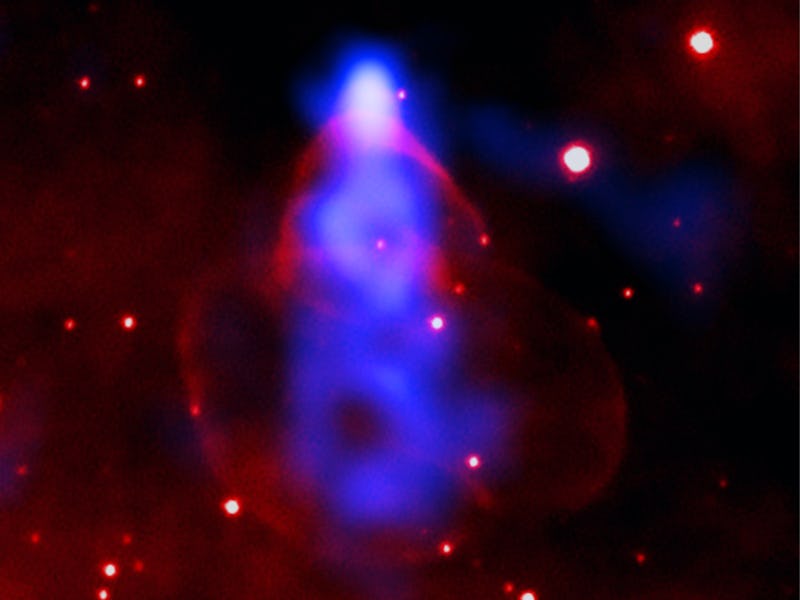Look: A small, powerful star just unleashed 40 trillion mile-long beam of antimatter
The massive beam is powered by a collapsed star.

Size doesn’t always matter in the cosmos. Sometimes, the tiniest of objects can put on powerful displays that span trillions of miles.
Astronomers recently imaged a gigantic beam of matter and antimatter shooting out of a small, spinning collapsed star. The beam stretches out about 40 trillion miles long, the longest ever observed from a pulsar star.
The astronomers detailed their recent observations in a study accepted for publication in The Astrophysical Journal.
“It's amazing that a pulsar that's only 10 miles across can create a structure so big that we can see it from thousands of light-years away,” Martijn de Vries, a researcher at Stanford University and lead author of the study, said in a statement. “With the same relative size, if the filament stretched from New York to Los Angeles the pulsar would be about 100 times smaller than the tiniest object visible to the naked eye.”
A pulsar is a fast rotating neutron star, or the super-dense remains of a star that exploded in a supernova. These stars emit electromagnetic radiation in the form of bright, narrow beams that sweep across the cosmos in a round motion as the star itself spins.
This pulsar is dubbed PSR J2030+4415, and is located about 1,600 light years away from Earth. It stretches about 10 miles across and rotates around at a dizzying pace of three times a second.
Astronomers first noticed the star’s beam back in the year 2020, but they couldn’t quite see all of its ginormous glory as it stretched beyond the edge of the Chandra detector, which they were using at the time.
But after going back to look at the star again using the Chandra X-ray Observatory in February and November 2021, the beam turned out to be three times as large as they had originally believed it to be.
The filament spans about half the diameter of the full Moon on the sky, making it the longest beam shooting from a pulsar as seen from Earth.
The beam itself contains matter and antimatter. Antimatter is the same mass as regular matter — the stuff that makes up cosmic objects in the universe — but with its electric charges reversed. It’s made up of so-called antiparticles, the counterpart to particles in regular matter. A positron is the positively charged equivalent to the electron.
Although most of the universe is made up of regular matter, scientists have discovered a relatively large number of positrons in detectors here on Earth, but they aren’t sure what the source of these positrons is.
The recent observations of the tiny pulsar star and its giant beam could provide insights into antimatter, and where it comes from in the universe. These stars combine fast rotation and high magnetic fields, which leads to particle acceleration and high-energy radiation that could create pairs of electrons and positrons.
Afterward, pulsar stars travel through the universe at high speeds of about a million miles per hour, leaving behind a trail of wind that contains charged particles.
The star has a bow shock of gas in front of it, similar to the pile-up of water in front of a moving boat, according to the statement. But the pulsar star has been moving too fast, even for its bow shock.
About 20 to 30 years ago, the pulsar star caught up to the bow shock and stalled its movement.
“This likely triggered a particle leak,” Roger Romani, a researcher at Stanford University and co-author of the study, said in a statement. “The pulsar wind's magnetic field linked up with the interstellar magnetic field, and the high-energy electrons and positrons squirted out through a nozzle formed by connection.”
As the particles floated through along the interstellar magnetic field line at about one-third the speed of light, they lit up in X-rays, resulting in the long beam seen by the astronomers.
The recent discovery suggests that particles can escape into interstellar space, and maybe even reach Earth.
This article was originally published on